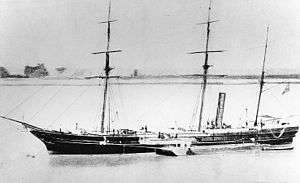CSS McRae
 CSS McRae, New Orleans, 1860 | |
| History | |
|---|---|
| Name: | Marqués de la Habana' |
| Namesake: | Marquis of Havana |
| Fate: | Captured by U.S. Navy 6 March 1860 |
| History | |
| Name: | CSS McRae |
| Acquired: | 17 March 1861 |
| Commissioned: | March 1861 |
| Fate: | Scuttled 28 April 1862 |
| General characteristics | |
| Displacement: | Approx. 680 tons |
| Propulsion: | Single screw, single expansion steam engine |
| Sail plan: | Bark-rigged sloop; three masts |
| Armament: | One 9-inch (229-mm) smoothbore, six 32-pounder smoothbores, one 6-pounder rifle |
| Armor: | None |
CSS McRae was a Confederate gunboat that saw service during the American Civil War. Displacing around 680 tons, she was armed with one 9-inch (229-mm) smoothbore and six 32-pounder smoothbore cannon.[1]:230
Originally operating as a rebel ship under the Mexican flag with the name Marqués de la Havana, the wooden sloop was captured as a pirate ship by the United States Navy sloop-of-war USS Saratoga during the Battle of Anton Lizardo on 6 March 1860. A construction plan authorizing the building of ten fast gunboats was funded by the Congress of the Confederate States on 15 March 1861. Recognizing that no yard could turn out the vessels fast enough, Confederate States Secretary of the Navy Stephen R. Mallory sent a commission to New Orleans, Louisiana, to convert existing steamers to commerce raiders. The Confederate States Navy purchased Marqués de la Havana at New Orleans on 17 March 1861, and duly fitted her out as CSS McRae as part of this plan. Extensive engine repairs prevented McRae from going to sea before the arrival of the Union blockading force.[2]:26
Placed under the command of Lieutenant Thomas B. Huger, McRae served as part of Flag Officer George N. Hollins' defense of the lower reaches of the Mississippi River, and provided cover for blockade runners. This led to McRae seeing combat with the Union blockading force on 12 October 1861. McRae took part in the Battle of the Head of Passes as part of Hollins′ "mosquito fleet," driving the Union blockading forces from the Head of Passes in the Mississippi Delta.
McRae again saw action on 24 April 1862 as the Union fleet attempted to pass Fort Jackson and Fort Saint Philip and reach New Orleans. In the resulting Battle of Forts Jackson and St. Philip, McRae suffered little damage in the beginning due to her resemblance to the Union Unadilla-class gunboats. The leading Union ships passed by her without firing. The sloop-of-war USS Iroquois was an exception, and replied to McRae′s gunfire with an 11-inch (279-mm) shell that set fire to McRae's sail room and threatened her magazines.[3] The officers and crew fought hard in this latter engagement but suffered severe casualties (Huger being amongst those mortally wounded), and McRae herself was severely damaged. She was run against the shore to put out her fires, and remained there till dawn, after which she returned to the forts. Loaded with wounded from the forts, McRae was allowed to return to New Orleans on 27 April 1862 under a flag of truce. After landing the wounded at the city, her crew scuttled and abandoned her at Algiers, Louisiana (now a neighborhood of New Orleans), after cutting all her steam pipes.[4]
References
- ↑ Silverstone, Paul H. (1989). Warships of the Civil War Navies. Naval Institute Press, Annapolis, Maryland. ISBN 0-87021-783-6.
- ↑ Hearn, Chester G. (1995). The Capture of New Orleans, 1862. Louisiana State University Press, Baton Rouge and London. ISBN 0-8071-1945-8.
- ↑ Hearn, The Capture of New Orleans, 1862 pp. 232-3
- ↑ Hearn, The Capture of New Orleans, 1862 p. 246
